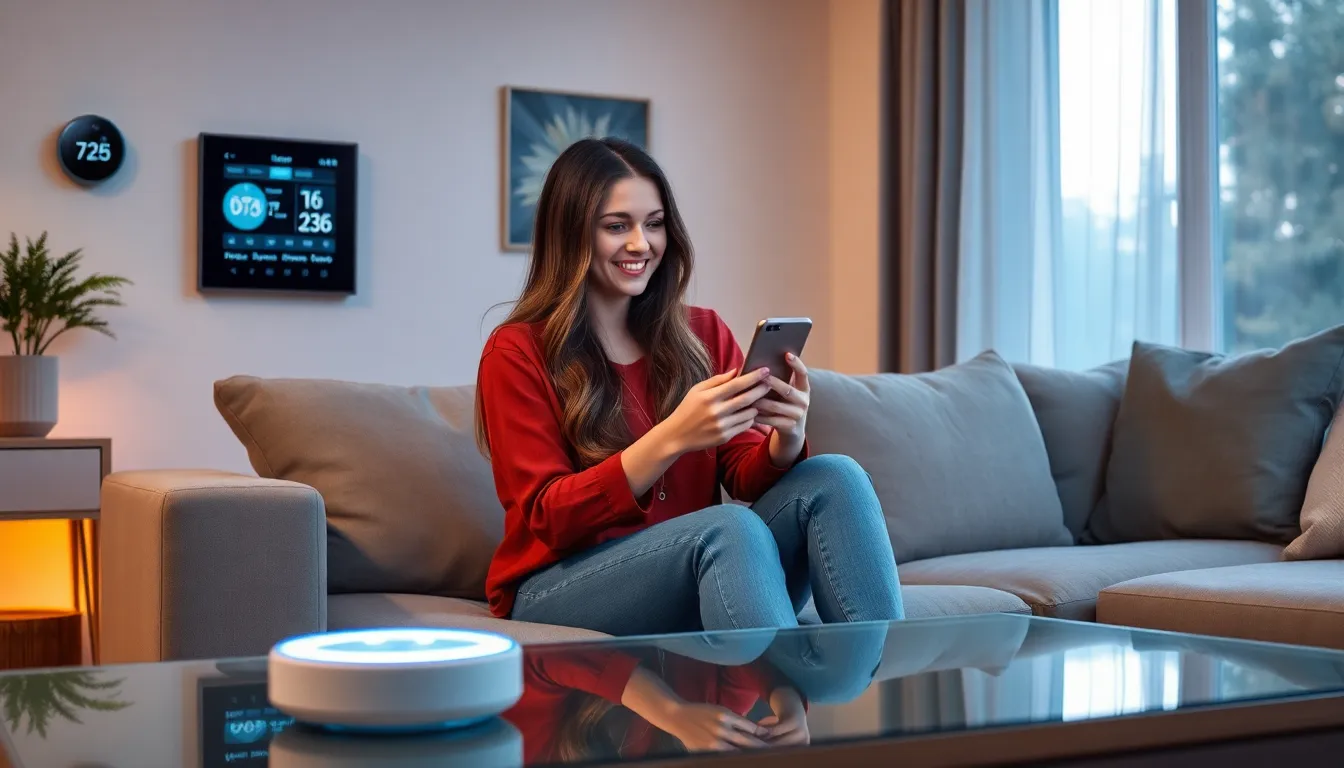In a world where even your toaster can send you a text, smart living is no longer just a futuristic dream—it’s a reality. Imagine a home that anticipates your every need, adjusting the lights, temperature, and even your morning coffee with just a whisper. Technology’s not just here to stay; it’s here to make life easier, one gadget at a time.
But let’s be real. With all these smart devices, it sometimes feels like they’re smarter than us. From voice assistants that can play your favorite songs to appliances that can order groceries, the question isn’t just how technology can help—it’s how it can keep you from losing your mind in the process. Dive into the world of smart living and discover how to embrace these innovations without losing your sense of humor. After all, who wouldn’t want a home that’s as clever as they are?
Table of Contents
ToggleOverview of Smart Living and Technology
Smart living integrates technology into daily life, transforming homes into automated spaces. Users can control various aspects like lighting, climate, and security from a single device. Automation simplifies tasks, enhancing comfort and convenience seamlessly. Sensors detect changes in the environment, enabling quick adjustments.
Cutting-edge devices like smart thermostats optimize energy use, leading to cost savings. Voice-activated assistants provide hands-free control, offering an easy way to manage schedules and information. Smart appliances, such as refrigerators, track food inventory while suggesting recipes based on available ingredients.
Interconnectivity among devices enables ecosystems that communicate with one another. Security systems monitor homes in real-time, sending alerts directly to smartphones. Data collected through smart devices helps users make informed decisions about their lifestyle choices.
Benefits extend beyond convenience. Smart technology promotes energy efficiency and sustainability, benefiting both users and the environment. Homeowners become empowered with tools that enhance safety and well-being, fostering a more secure living atmosphere.
Embracing these innovations encourages adaptability in a rapidly evolving world. As technology continues to advance, opportunities for further integration within living spaces will expand, shaping the future of home life.
Benefits of Smart Living

Smart living enhances daily routines through technology, prioritizing convenience and efficiency.
Improved Efficiency
Smart technology streamlines household tasks, leading to significant time savings. Smart thermostats adjust temperatures automatically based on user preferences and schedules. Energy-efficient appliances monitor energy usage, reducing costs over time. With centralized controls, users can manage devices from a single interface, simplifying operations. Automation tools also allow pre-scheduling of activities, ensuring things happen seamlessly without manual input. Consequently, tasks that once felt tedious now require minimal effort, freeing up time for more enjoyable pursuits.
Enhanced Comfort
Smart living creates an environment tailored to individual preferences, boosting overall comfort. Smart lighting systems adapt to the time of day, enhancing ambiance throughout the home. Heating and cooling systems respond to real-time data, maintaining optimal temperatures effortlessly. Voice-activated assistants can manage various tasks, from setting reminders to controlling the music playing in a room. Additionally, smart beds adjust firmness and position for a personalized sleep experience, promoting better rest. Ultimately, technology transforms living spaces into comfortable sanctuaries that cater to personal needs and desires.
Key Technologies in Smart Living
Smart living integrates various technologies that enhance daily life and create automated environments. Users benefit from streamlined operations and increased convenience through these innovations.
Smart Home Devices
Smart home devices transform ordinary houses into intelligent spaces. Devices such as smart thermostats automatically adjust temperatures based on user preferences, optimizing energy consumption. Security cameras provide real-time surveillance, while smart locks offer keyless entry options. Voice-activated assistants connect seamlessly with other gadgets, allowing users to control lights, appliances, and music hands-free. Smart appliances, including refrigerators and washing machines, monitor usage and suggest improvements, further enhancing efficiency. Homeowners can control these devices remotely via smartphone applications, providing peace of mind and convenience when away from home.
Wearable Technology
Wearable technology enhances personal health monitoring and everyday convenience. Devices like smartwatches and fitness trackers enable individuals to monitor heart rate, track exercise, and analyze sleep patterns effortlessly. Users stay motivated through notifications about physical activity and health goals. Smart clothing integrates sensors that provide real-time data, making fitness more efficient. Notifications about incoming calls and messages can be accessed through these devices, reducing distractions from phones. Wearables often sync with other smart home devices, creating a holistic approach to personal health and home automation.
Challenges of Smart Living
Smart living offers many advantages, but it also comes with challenges that users must navigate. Understanding these issues helps users adapt effectively to a technology-driven lifestyle.
Privacy Concerns
Privacy concerns remain a significant challenge in smart living. Many devices collect data on user behavior, which can lead to potential misuse. Smart home gadgets, like security cameras and voice assistants, often store sensitive information, making users vulnerable to hacking. Cybersecurity breaches expose personal data, raising alarms among consumers. Companies ensure data protection measures but inconsistencies in security practices may leave gaps. Users must choose devices from reputable manufacturers and remain vigilant about sharing information.
Integration Issues
Integration issues often arise when combining various smart devices. Compatibility between brands isn’t always guaranteed, leading to frustration for users. Many manufacturers create ecosystems that may not communicate seamlessly with third-party devices. This lack of interoperability affects user experience by complicating control systems. As a result, homeowners may need to rely on multiple applications for managing their devices. Simplifying integration requires ongoing improvements from manufacturers focused on effective communication protocols. Addressing compatibility challenges becomes essential for optimizing smart living environments.
Future Trends in Smart Living and Technology
Smart living and technology continue to evolve, bringing exciting changes to everyday environments. Voice recognition technology advances, allowing smoother interactions with smart devices. Artificial intelligence enhances personalization, enabling systems to learn user habits and preferences.
Connected ecosystems become increasingly common, integrating various devices into a cohesive network. Homeowners benefit from smart appliances that communicate, optimizing energy usage and performance through coordinated actions. Sensors also improve in accuracy, ensuring timely adjustments for heating, cooling, and lighting.
Wearable devices play a significant role, not only tracking fitness but providing health data that syncs with home systems. This connection promotes a comprehensive health management approach, streamlining routines for users. Moreover, augmented reality and virtual reality technology gain traction, creating interactive experiences in smart living spaces.
Privacy concerns remain a priority as data collection intensifies. Organizations work toward establishing robust security measures that protect user information while enhancing device functionality. Improved communication protocols are essential, fostering better integration between devices from different manufacturers.
Sustainability drives future innovations in smart living. Energy-efficient technologies expand, with smart grids and renewable energy systems becoming accessible. These advancements not only reduce carbon footprints but also promote cost savings for users.
The integration of smart living technologies and solutions leads to smarter urban planning. Cities embrace smart infrastructures, utilizing data analytics to enhance public services and improve quality of life. As cognitive technologies evolve, it becomes clear that the future of smart living appears both promising and dynamic.
Embracing smart living and technology offers a pathway to a more efficient and comfortable lifestyle. As homes evolve into interconnected ecosystems that respond to individual needs, the convenience these innovations provide is undeniable.
However it’s crucial to remain aware of the potential challenges that come with this technological shift. Prioritizing privacy and security while navigating the smart living landscape is essential for a safe experience.
Looking ahead the future of smart living promises even more exciting advancements. With a focus on sustainability and enhanced user interaction smart technology will continue to transform everyday life. Adopting these innovations with an open mind can lead to a more enjoyable and streamlined home environment.






